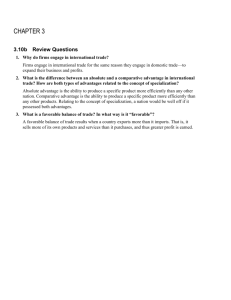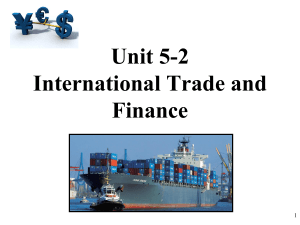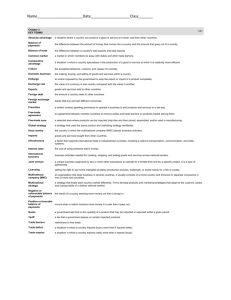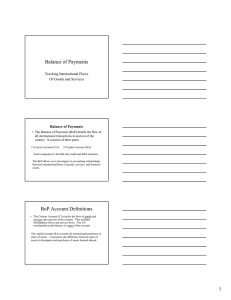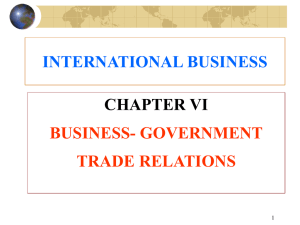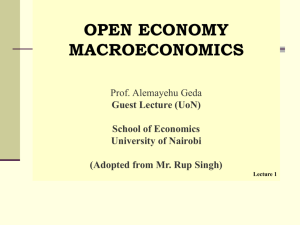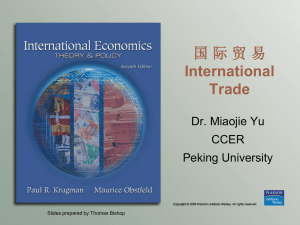INTERNATIONAL TRADE
advertisement
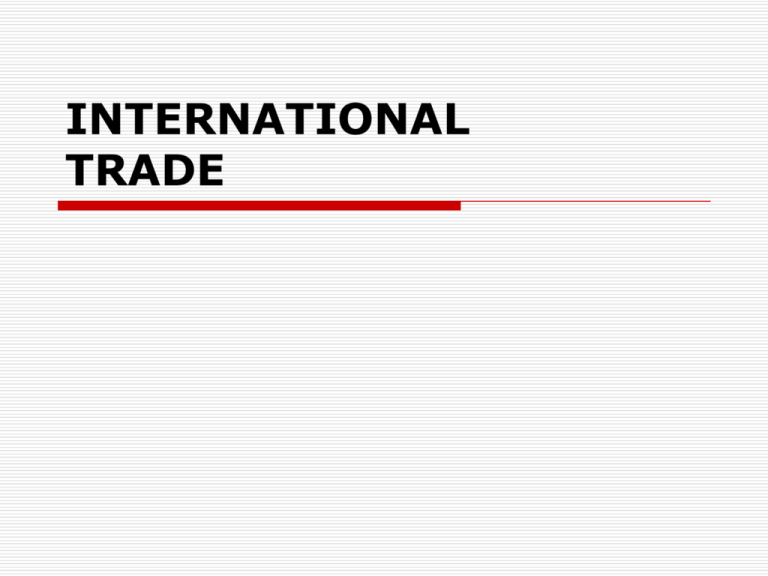
INTERNATIONAL TRADE INTERNATIONAL TRADE GLOBAL TRADE WORLD TRADE REGIONAL TRADE FOREIGN TRADE vs. LOCAL (DOMESTIC, HOME) TRADE EXPORTING AND IMPORTING (NOUNS AND VERBS) EXPORTER / IMPORTER Last year, the United States EXPORTED cotton to Italy, and IMPORTED olive oil from that country. Croatia should increase its EXPORTS. The country's IMPORTS are very high. (n.pl.) Vegeta is AN EXPORT for Croatia and AN IMPORT for Hungary. (n.sg.) Find opposites: deficit - surplus earnings - expenditure debit - credit exports - imports trade liberalisation, free trade- protectionism visible trade - invisible trade developed countries - developing countries, less developed countries (LDC), underdeveloped countries BALANCE OF PAYMENTS «A nations' balance of payments statement records all transactions between its residents and the residents of other foreign nations (including individuals, businesses and governmental units). These transactions include all visible exports and imports, imports and exports of services, tourist expenditures, interest and dividends received or paid abroad, purchases and sales of financial or real assets abroad etc. « McConnell, Brue: Economics (1996) VISIBLE OR INVISIBLE TRADE? EXPORTS OR IMPORTS? e.g.This is an export for X, and an import for Y. 1. An Englishman buys some olive oil in France and takes it back to England. 2. An English person buys a ticket for the Dubrovnik summer festival. 3. An Italian working in England buys an Italian car in England. VISIBLE OR INVISIBLE TRADE? EXPORTS OR IMPORTS? e.g.This is an export for X, and an import for Y. 4. A German buys a ticket to watch an American band play in Germany. 5. A Norwegian ship carries frozen lamb from New Zealand to England. 6. A Canadian ship owner insures his ship in London. Fill in: liabilities, deficit, current account, record, transactions, assets, credit, debit, payments The balance of 1.............(BOP) is the place where countries 2............... their monetary .3................ with the rest of the world. Transactions are either marked as a 4............or a debit. If a country has received money, this is known as a 5.........., and, if a country has paid or given money, the transaction is counted as a 6........... Theoretically, the BOP should be zero, meaning that ...........(credits) and 7................(debits) should balance. But in practice this is rarely the case and, thus, the BOP can tell the observer if a country has a 8.................or a surplus. Within the BOP there are three separate categories under which different transactions are categorized: the current account, the capital account and the financial account. In the 9......................., goods, services, income and current transfers are recorded. In the capital account, physical 10.............. such as a building or a factory are recorded. And in the financial account, assets pertaining to international monetary flows of, for example, business or portfolio investments are noted. http://www.investopedia.com/articles/03/061803.asp BALANCE OF TRADE DEFICIT (TRADE DEFICIT) BALANCE OF TRADE SURPLUS (TRADE SURPLUS) BALANCE OF PAYMENTS DEFICIT BALANCE OF PAYMENTS SURPLUS Match the two columns: (based on MacKenzie, p.156, pg.1) Comparative Raise Real Absolute Comparative Factors of Division of labour production income cost principle living standards advantage advantage PROTECTIONISM vs. FREE TRADE trade barriers protectionism quotas open borders tariffs laissez-faire deregulation strategic industries liberalise subsidise infant industries restrictions customs duties import substitution How would you classify the words from the previous slide (protectionism vs. free trade)? In favour of free trade: Against free trade: Trade Regulations and Croatia WTO Harmonise with EU rules Trade in (textiles) Transition period Range from … to … Lift customs duties Account for x% Accession Interim agreement Bilateral relations Source: R: p.28 What do the figures stand for? 30 2003, 0.0-17.6% Less than 10% 3% 22-24% 2001 50% 17% ¼ 2000 2003 2009 Source: R:p.28 PROTECTIONISM AND FREE TRADE to impose ease lower remove lift tariffs/quotas, ... elections / tariffs, quotas / strategic industries / unemployment – link? (pg.3) reasons for trade barriers (p.156, pg.3,4) Differences: tariffs, quotas and other non-tariff barriers (pg.5) TOWARDS FREE TRADE GATT and WTO GATT objectives and the WTO (pg.6) The MFN clause Trading blocks: e.g. EU, NAFTA, ... WTO “The World Trade Organization (WTO) is the only international organization dealing with the global rules of trade between nations. Its main function is to ensure that trade flows as smoothly, predictably and freely as possible.” (www.wto.org) issues negotiated within the WTO agriculture (subsidies distorting prices) e.g. 18 Dec 05, Hong Kong “World Trade Organisation ministers reached a compromise agreement in Hong Kong, that sets an end-date of 2013 for farm export subsidies and offers export help to the world’s poorest nations.” (Financial Times) “After securing commitments from others to reform their own export subsidies, the EU has offered to eliminate its export refund system by 2013, conditional on similar moves from others.” (europa.eu.int) industrial products, services, intellectual property, investment, competition, transparency in government procurement, trade facilitation, anti-dumping, subsidies, regional trade agreements, trade and environment DEVELOPING COUNTRIES AND FREE TRADE Developing countries... (pg.7, 8, 9) opposed................................. saw...................................... wanted................................. practised................................. imposed................................. have................................. are unable................................. need to................................. are aware of........................ are afraid of......................... tend to ............................... THE BANANA WAR (MK: p.159) 1. How does reduction of trade barriers affect international trade? 2. How did the EU protect British and French colonies? 3. What did the US do? Why? 4. What were the EU arguments? 5. How did the trade dispute end?





